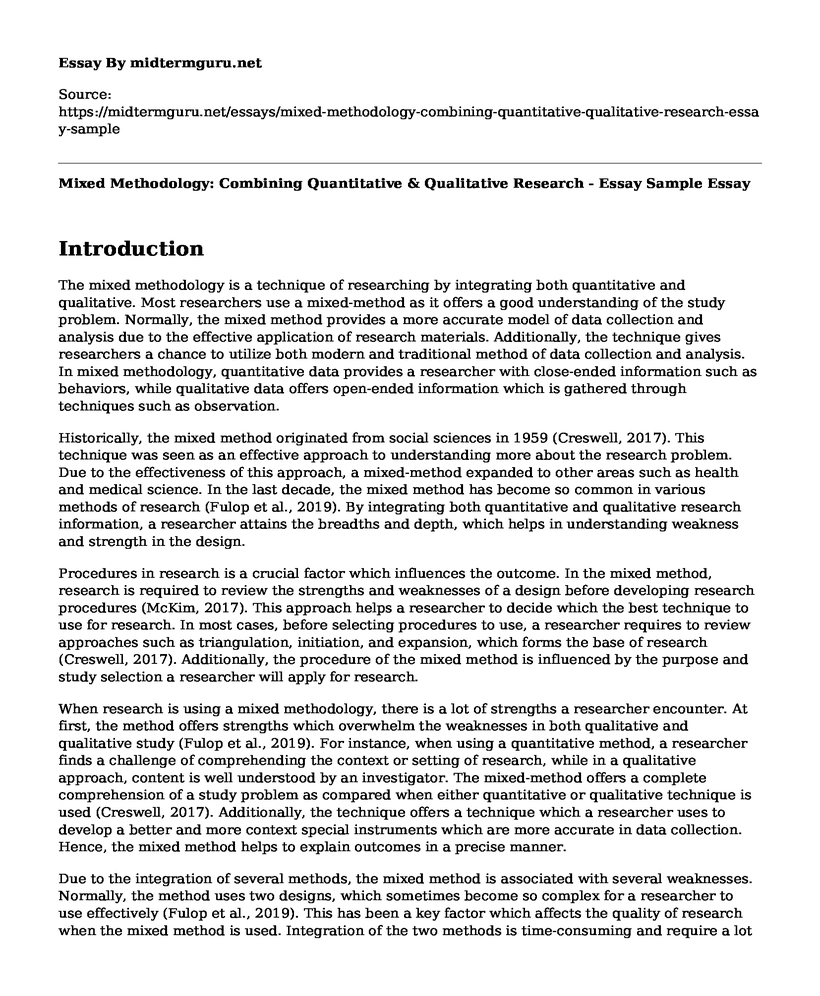Introduction
The mixed methodology is a technique of researching by integrating both quantitative and qualitative. Most researchers use a mixed-method as it offers a good understanding of the study problem. Normally, the mixed method provides a more accurate model of data collection and analysis due to the effective application of research materials. Additionally, the technique gives researchers a chance to utilize both modern and traditional method of data collection and analysis. In mixed methodology, quantitative data provides a researcher with close-ended information such as behaviors, while qualitative data offers open-ended information which is gathered through techniques such as observation.
Historically, the mixed method originated from social sciences in 1959 (Creswell, 2017). This technique was seen as an effective approach to understanding more about the research problem. Due to the effectiveness of this approach, a mixed-method expanded to other areas such as health and medical science. In the last decade, the mixed method has become so common in various methods of research (Fulop et al., 2019). By integrating both quantitative and qualitative research information, a researcher attains the breadths and depth, which helps in understanding weakness and strength in the design.
Procedures in research is a crucial factor which influences the outcome. In the mixed method, research is required to review the strengths and weaknesses of a design before developing research procedures (McKim, 2017). This approach helps a researcher to decide which the best technique to use for research. In most cases, before selecting procedures to use, a researcher requires to review approaches such as triangulation, initiation, and expansion, which forms the base of research (Creswell, 2017). Additionally, the procedure of the mixed method is influenced by the purpose and study selection a researcher will apply for research.
When research is using a mixed methodology, there is a lot of strengths a researcher encounter. At first, the method offers strengths which overwhelm the weaknesses in both qualitative and qualitative study (Fulop et al., 2019). For instance, when using a quantitative method, a researcher finds a challenge of comprehending the context or setting of research, while in a qualitative approach, content is well understood by an investigator. The mixed-method offers a complete comprehension of a study problem as compared when either quantitative or qualitative technique is used (Creswell, 2017). Additionally, the technique offers a technique which a researcher uses to develop a better and more context special instruments which are more accurate in data collection. Hence, the mixed method helps to explain outcomes in a precise manner.
Due to the integration of several methods, the mixed method is associated with several weaknesses. Normally, the method uses two designs, which sometimes become so complex for a researcher to use effectively (Fulop et al., 2019). This has been a key factor which affects the quality of research when the mixed method is used. Integration of the two methods is time-consuming and require a lot of resources to conduct all activities (McKim, 2017). Finally, it may appear challenging to plan and implement both qualitative and quantitative method.
When selecting the type of mixed-method, research is first required to review weaknesses and strengths based on the research question. There are four types of mixed-method research; sequential explanatory, sequential exploratory, concurrent triangulation, and concurrent nested (Creswell, 2017). These modes of mixed methods are differentiated based on the method of data collection and analysis.
References
Creswell, J. W. (2017). Research design: Qualitative, quantitative, and mixed methods approaches. (5th Ed.). Thousand Oaks, CA: Sage Publications.
Fulop, N. J., Ramsay, A., Hunter, R. M., McKevitt, C., Perry, C., Turner, S. J., & Wolfe, C. D. (2019). Evaluation of reconfigurations of acute stroke services in different regions of England and lessons for implementation: a mixed-methods study. Health Services Delivery Research, 7(7).
McKim, C. A. (2017). The value of mixed methods research: A mixed methods study. Journal of Mixed Methods Research, 11(2), 202-222. Retrieved from didier-jourdan.com/wp-content/uploads/2017/04/MM-and-Graduates-students.pdf.
Cite this page
Mixed Methodology: Combining Quantitative & Qualitative Research - Essay Sample. (2023, Feb 05). Retrieved from https://midtermguru.com/essays/mixed-methodology-combining-quantitative-qualitative-research-essay-sample
If you are the original author of this essay and no longer wish to have it published on the midtermguru.com website, please click below to request its removal:
- Paper Sample on Noise Based Modulation Techniques
- Accounting Information System: Technology in Financial Reporting - Research Paper
- JB Hi-Fi's Financial Reports: Rules, Concepts & Qualitative Characteristics - Essay Sample
- Digital Privacy: Securing Your Data in the Age of Mobile Devices - Essay Sample
- Secure Your Wireless Network: Protect Against Data Intruders - Research Paper
- Article Analysis Essay on "The Shutdown Price, Reconsidered"
- TeleClinic: A Leader in Telemedicine & Teleradiology Services - Essay Sample







